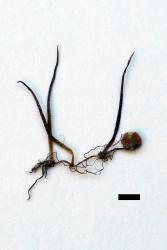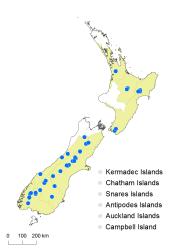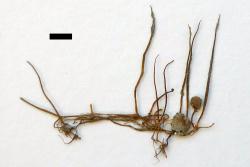- ≡ Calamistrum novae-hollandiae (A.Br.) Kuntze, Revis. Gen. Pl. 2, 822 (1891)
- = Pilularia novae-zealandiae Kirk, Trans. & Proc. New Zealand Inst. 9: 547, t. 29 (1877) – as novae zealandiae
- ≡ Calamistrum novae-zelandiae (Kirk) Kuntze, Revis. Gen. Pl. 2, 822 (1891)
Aquatic or subaquatic fern, forming spreading clumps. Rhizomes long-creeping, c. 0.2 mm in diameter, rooting at nodes, straw-coloured, almost glabrous. Leaves solitary at each node, 10–60 mm long, rarely up to 90 mm long, 0.2–0.5 mm in diameter, tapering to the apex, lacking flattened segments, glabrous. Sporocarps solitary, globose, 2–4 mm in diameter, densely hairy, sessile or on stalks 1–4 mm long.
An easily over-looked and unfern-like plant, often only recognised by the coiling of the young leaves, and by the sporocarps when they are present.
North Island: Auckland, Volcanic Plateau, Gisborne, Southern North Island.
South Island: Marlborough, Westland, Canterbury, Otago, Southland, Fiordland.
Altitudinal range: 0–1100 m.
In the North Island, Pilularia novae-hollandiae occurs from 0–950 m in the Waikato River and around Lakes Whāngāpē, Waahi, Aratiatia, Kaitawa, Waikaremoana, Waikareiti, Taupō and Wairarapa. In the South Island it is found along the Southern Alps from Lake Rotoroa to Lake Monowai at 10–1100 m, in lakes along the west coast, and in outlying populations at Falls Dam near St Bathans and Lake Onslow north of the Lammerlaw Range.
Also Australia (Western Australia, South Australia, NSW, Victoria, Tasmania).
Grows submerged on stony or muddy bottoms in water up to 1 m deep, and on mud and silt left around lakes when the water level drops in dry periods. Sporocarps are produced in summer as the lakes begin to dry out and the water level recedes.
2n = c. 20 (Large & Braggins 1989)
Pilularia novae-zealandiae was described from New Zealand by Kirk (1877a), and distinguished from P. novae-hollandiae by the number of sori and megaspores. Cheeseman (1925) and Allan (1961) both accepted P. novae-zealandiae as an endemic species. However, Large & Braggins (1989) compared the morphology of P. americana, P. novae-hollandiae and P. novae-zealandiae and concluded that they were extremely similar. Nagalingum et al. (2008) investigated the phylogenetic relationships of these species using five different gene markers. They concluded that there was no sequence divergence between P. novae-hollandiae and P. novae-zealandiae and that the two were conspecific. The name P. novae-hollandiae has nomenclatural priority and is therefore adopted here for the New Zealand plant.
Kirk used the name P. novae zealandiae for his new species, but Webb & Edgar (1999) suggested that the specific epithet should take a hyphen.






